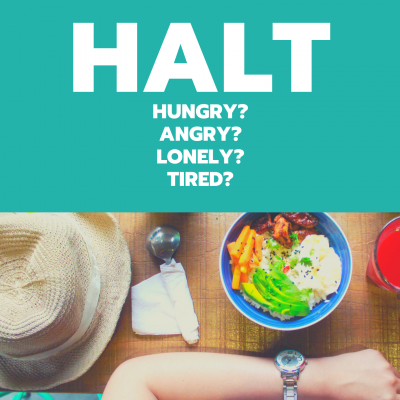With extra downtime and limitation on what and where you can go, you may find yourself opening the fridge or looking in the pantry for no particular reason. Maybe you’re bored, sad, frustrated, happy, or exhausted. Regardless, eating to manage emotions is an unhealthy habit, and over time can lead to unwanted pounds, especially during this time of quarantine.
This month I want to inspire you to HALT before grabbing another handful of chips, opening the fridge for another snack, or searching the pantry for a sweet treat. - Stephanie
|
|
|
HALT?
|
 HALT is an acronym that can help you discover WHY you are about to eat. It stands for: HALT is an acronym that can help you discover WHY you are about to eat. It stands for:
H - Hungry
A - Angry or Anxious
L - Lonely
T - Tired
HALT is a tool to help enhance your ability to check in with your emotional and physical state and help prevent mindless eating.
Before digging into that plate of cookies, snacking on more nuts, pouring a cocktail or going for the second serving, HALT and ask yourself...
“Am I Hungry?” Hunger is your body’s signal that you need nourishment to fuel yourself and ensure your body operates at its full potential. Real hunger does not come on suddenly, yet it is a gradual process and begins to increase as time goes on. When your body tells you that you are hungry, it’s time to eat and refuel with food that provides nourishment. However, be aware of the difference between hunger and other emotional reasons you might want to eat. If you are not hungry, then continue to walk through the steps of HALT and identify the reason you want to turn to food.
“Am I Angry or Anxious?” This time brings to the surface a mix of emotions, but being aware of the feelings can promote care for your mental and physical health. Anger and anxiety are both associated with stress and cause an increase in appetite. Start by slowing down, take a deep breath, and identify your emotions.
“Am I Lonely?” Loneliness is a common reason people turn to food for comfort. Food, especially choices high in refined carbohydrates and sugar, send the “feel good” hormone, serotonin to the brain. This is why it feels food brings comfort, and mindlessly eating can become an unhealthy habit, especially during stressful times.
“Am I Tired?” Tiredness is a sign of being overworked and overwhelmed, and the need for rest can easily be confused with the desire for food. When you feel exhausted, you crave carbohydrates to fill that void, which gives you a quick energy rush but leaves you empty in nutrients. Inadequate sleep can also interfere with your hormones, ghrelin, and leptin, which can also lead to an increase in appetite. It is essential to your health emotionally, physically, and mentally to establish a time each day to get good sleep and rest.
|
|
|
Tips for HALTing
|
 Hungry: Grab a nutritious snack like almonds, Greek yogurt, a cup of fruit or vegetables to hold you over until mealtime. Incorporate a glass of water with your snack to help you feel satisfied. Hungry: Grab a nutritious snack like almonds, Greek yogurt, a cup of fruit or vegetables to hold you over until mealtime. Incorporate a glass of water with your snack to help you feel satisfied.
Angry: Take time to reflect by journaling how the situation made you feel and how you can confront it. Go for a walk or run, scream into a pillow, paint, or turn on music and clean out that closet you have been eager to start.
Lonely: Spend time engaged in a new hobby. Decorate your home, cook yourself a nutritious-packed meal, and curl up on the couch and watch a funny movie. Call a friend and schedule a web call so you can see each other! Immerse yourself into laughter by watching funny dog videos or your favorite sitcom.
Tired: Set your alarm clock and take a power nap to satisfy the need to sleep, rest, and rejuvenate. Relax and enjoy a bubble bath, meditate, participate in music therapy to help you relax, or go for a walk instead of rummaging through the cabinets.
|
|
Featured Recipe
Recipe of the Month: Make-Ahead Mediterranean Egg Casserole
|
 Recipe by Egglands Best Recipe by Egglands Best
1 teaspoon olive oil
1/2 small red onion, sliced
2 cloves garlic, finely chopped
1 (14-ounce) can water-packed artichokes, drained and chopped
6 ounces baby spinach (about 6 cups)
1 cup grape or cherry tomatoes, halved (about 5 ounces)
4 ounces feta cheese, crumbled (about 1 cup)
1/2 ounce Parmesan cheese, finely grated (about 1/4 cup)
1 tablespoon fresh oregano leaves
12 Eggland's Best egg (large)
1 1/4 teaspoons kosher salt, divided
2 cups whole or 2% milk
1/4 teaspoon freshly ground black pepper
Arrange a rack in the middle of the oven and heat the oven to 375°F. Coat a 9x13-inch baking dish with olive oil.
Heat 1 teaspoon olive oil in a large skillet over medium-high heat until shimmering. Add the red onion and 1/2 teaspoon of the kosher salt, and cook until soft, 2 to 3 minutes. Add the garlic and artichokes and cook until the garlic is fragrant, about 1 minute. Add 6 ounces spinach (about 6 cups) and cook until just wilted about 2 minutes.
Transfer the vegetables to the prepared baking dish and arrange in an even layer. Sprinkle the tomatoes and feta cheese evenly over the vegetables.
Whisk the Parmesan, oregano, 12 Eggland's Best large eggs, 2 cups whole or 2% milk, 1/4 teaspoon black pepper, and remaining 3/4 teaspoon kosher salt together in a large bowl until combined. Pour the egg mixture over the vegetables.
Bake until puffed, set, and an instant-read thermometer inserted into the center reads 160°F, about 30 minutes. Let the casserole cool for 10 minutes before serving.
Serves 10
Nutrition per serving: Calories 106, Fat 5.5 g, Saturated Fat 3.4 g, Cholesterol 225 mg, Sodium 306 mg, Carbohydrates 9 g, Fiber 2.8 g, Protein 6.5 g
|
|
|
Be Inspired
|
|
"Now and then it's good to pause in our pursuit of happiness and just be happy."
Guillaume Apollinaire
|
|
|
About SO Nutrition
|
 Stephanie Leipprandt Ouellette, MBA, RDN, LD
Stephanie Leipprandt Ouellette, MBA, RDN, LD Stephanie has been working in the field of nutrition and dietetics since 1995. She earned a Bachelor of Science degree in Dietetics from Michigan State University, completed an Approved Pre-Professional Practice Program at Western Michigan University and earned a Master of Business Administration from Baker College. She’s been a Registered Dietitian Nutritionist since 1996 and licensed in Texas since 2007. In 2008, Stephanie earned her certification in Childhood and Adolescent Weight Management. Stephanie has extensive clinical & managerial experience, both in corporate settings and in the community. Now she wants to share her knowledge with you, because most (if not all) nutritional habits begin at home.
Stephanie and her family reside in Katy, Texas
|
|
| |
Copyright © 2020 Customized Nutrition Newsletters, All rights reserved.
|
|
| |
|
|